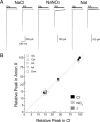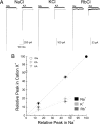Cations but not anions regulate the responsiveness of kainate receptors
- PMID: 21307250
- PMCID: PMC6633048
- DOI: 10.1523/JNEUROSCI.4314-10.2011
Cations but not anions regulate the responsiveness of kainate receptors
Abstract
Kainate-selective ionotropic glutamate receptors are unique among ligand-gated ion channels in their obligate requirement of external anions and cations for activation. Although it is established that the degree of kainate receptor (KAR) activation is shaped by the chemical nature of the agonist molecule, the possible complementary role of external ions has yet to be examined. Here we show that external cations but not anions regulate the responsiveness to a range of full and partial agonists acting on rat GluK2 receptors. This observation is unexpected as previous work has assumed anions and cations affect KARs in an identical manner through functionally coupled binding sites. However, our data demonstrate that anion- and cation-binding pockets behave discretely. We suggest cations uniquely regulate a pregating or flipping step that impacts the closed-cleft stability of the agonist-binding domain (ABD). This model departs from a previous proposal that KAR agonist efficacy is governed by the degree of closure elicited in the ABD by ligand binding. Our findings are, however, in line with recent studies on Cys-loop ligand-gated ion channels suggesting that the "flipping" mechanism has been conserved by structurally diverse ligand-gated ion channel families as a common means of regulating neurotransmitter behavior.
Figures








Similar articles
-
Distinct functions of kainate receptors in the brain are determined by the auxiliary subunit Neto1.Nat Neurosci. 2011 May 29;14(7):866-73. doi: 10.1038/nn.2837. Nat Neurosci. 2011. PMID: 21623363 Free PMC article.
-
Molecular basis of kainate receptor modulation by sodium.Neuron. 2008 Jun 12;58(5):720-35. doi: 10.1016/j.neuron.2008.04.001. Neuron. 2008. PMID: 18549784 Free PMC article.
-
External anions and cations distinguish between AMPA and kainate receptor gating mechanisms.J Physiol. 2002 Mar 15;539(Pt 3):725-33. doi: 10.1113/jphysiol.2001.013407. J Physiol. 2002. PMID: 11897844 Free PMC article.
-
Pharmacological activity of C10-substituted analogs of the high-affinity kainate receptor agonist dysiherbaine.Neuropharmacology. 2010 Mar;58(3):640-9. doi: 10.1016/j.neuropharm.2009.11.013. Epub 2009 Dec 4. Neuropharmacology. 2010. PMID: 19962997 Free PMC article.
-
Ion-dependent gating of kainate receptors.J Physiol. 2010 Jan 1;588(Pt 1):67-81. doi: 10.1113/jphysiol.2009.178863. Epub 2009 Oct 12. J Physiol. 2010. PMID: 19822544 Free PMC article. Review.
Cited by
-
Role of conformational dynamics in α-amino-3-hydroxy-5-methylisoxazole-4-propionic acid (AMPA) receptor partial agonism.J Biol Chem. 2012 Dec 21;287(52):43557-64. doi: 10.1074/jbc.M112.371815. Epub 2012 Oct 31. J Biol Chem. 2012. PMID: 23115239 Free PMC article.
-
Transmembrane AMPA receptor regulatory protein regulation of competitive antagonism: a problem of interpretation.J Physiol. 2011 Nov 15;589(Pt 22):5383-90. doi: 10.1113/jphysiol.2011.219485. Epub 2011 Oct 3. J Physiol. 2011. PMID: 21969453 Free PMC article.
-
Structural Mechanisms of Gating in Ionotropic Glutamate Receptors.Biochemistry. 2018 Jan 23;57(3):267-276. doi: 10.1021/acs.biochem.7b00891. Epub 2017 Oct 27. Biochemistry. 2018. PMID: 29037031 Free PMC article.
-
Structure, Function, and Pharmacology of Glutamate Receptor Ion Channels.Pharmacol Rev. 2021 Oct;73(4):298-487. doi: 10.1124/pharmrev.120.000131. Pharmacol Rev. 2021. PMID: 34753794 Free PMC article. Review.
-
The structural arrangement at intersubunit interfaces in homomeric kainate receptors.Sci Rep. 2019 May 6;9(1):6969. doi: 10.1038/s41598-019-43360-x. Sci Rep. 2019. PMID: 31061516 Free PMC article.
References
-
- Armstrong N, Gouaux E. Mechanisms for activation and antagonism of an AMPA-sensitive glutamate receptor: crystal structures of the GluR2 ligand binding core. Neuron. 2000;28:165–181. - PubMed
-
- Armstrong N, Sun Y, Chen GQ, Gouaux E. Structure of a glutamate-receptor ligand-binding core in complex with kainate. Nature. 1998;395:913–917. - PubMed
-
- Armstrong N, Jasti J, Beich-Frandsen M, Gouaux E. Measurement of conformational changes accompanying desensitization in an ionotropic glutamate receptor. Cell. 2006;127:85–97. - PubMed
Publication types
MeSH terms
Substances
Grants and funding
LinkOut - more resources
Full Text Sources
Miscellaneous
